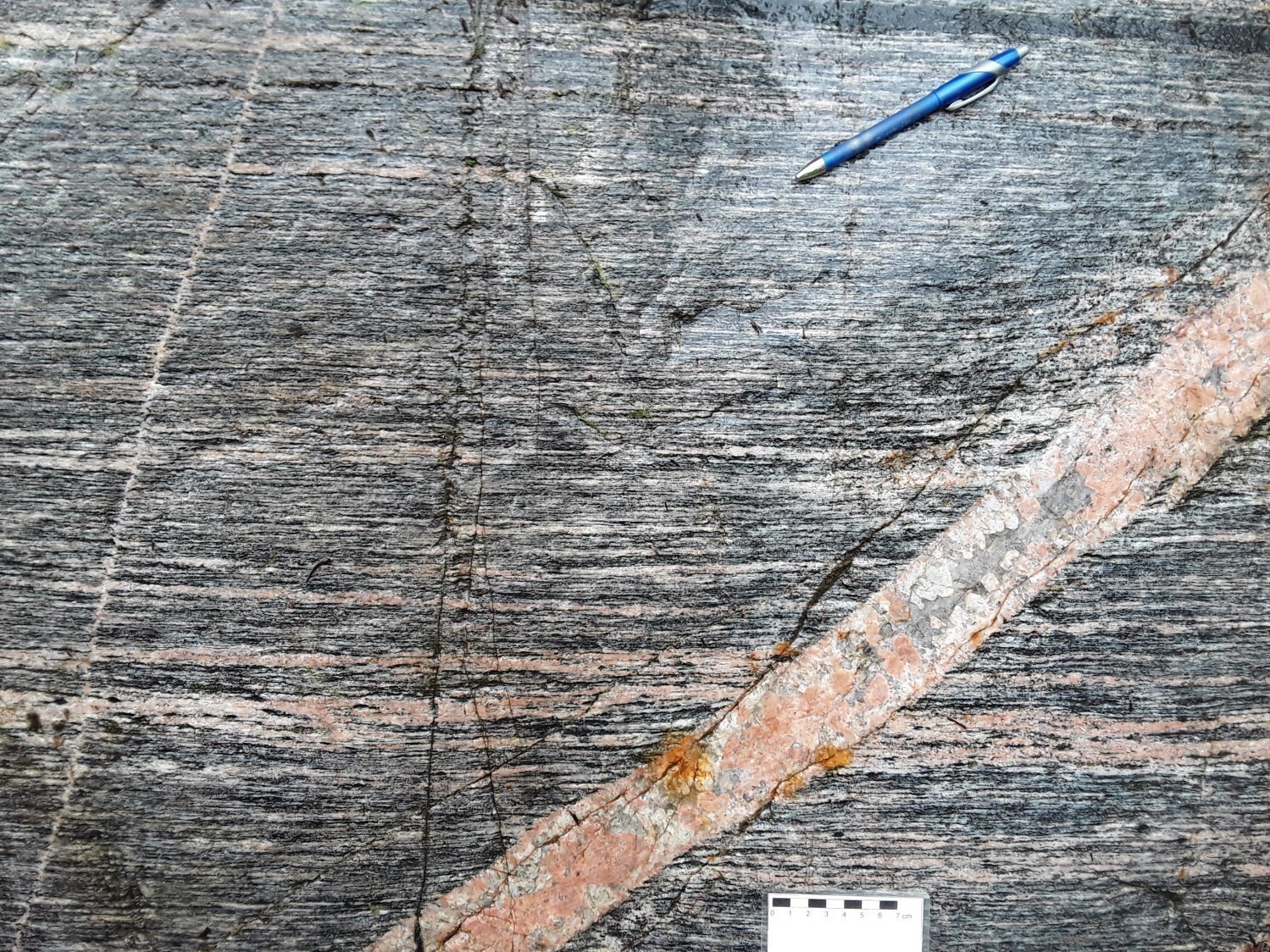
| Author(s) | El Bourki and Moukhsil, 2022 |
| Methodology | Defined from geological survey |
| Geological(s) subdivision(s) | Grenville Province/Allochton |
| Main movement | – |
| Deformation style | Polyphase folding |
| Metamorphic facies (mean facies related to main deformation) | Upper amphibolites to granulites |
Background and Methodology
The Adélard Structural Domain (DSade) was defined from a geological mapping survey conducted by El Bourki and Moukhsil (2022) in the Dolbeau-Blondelas area (NTS sheet 32H07). Its name refers to Adélard Lake located in the northwestern part of sheet 32h07.
Boundaries and Morphology
| Width | Average width: 14 km (E-W axis) |
| Length | Average length: 22 km (N-S axis) |
| Orientation | North-south elongation |
The Adélard Structural Domain (DSade) occupies the western part of sheet 32H07. It is bounded to the south by the Jean-Marie Structural Domain (DSjme), to the southeast by the Vertu Structural Domain (DSvtu) and to the northeast by the Crevier Structural Domain (DScre). The DSade appears to continue westward and northward into the region (sheets 32H06, 32H10 and 32H11) along a N-S elongation.
Stratigraphic Units Concerned
The stratigraphic units within the Adelard Structural Domain are:
–the Adelard Plutonic Suite (mPade);
–the Festins Plutonic Suite (mPfes);
–the Vertu Plutonic Suite (mPvet2);
–the Barrois Complex (mPboi4).
Structural Characteristics
In the Adelard Structural Domain, the rocks show a planar fabric that is expressed mainly by secondary mineral foliation, by foliation or mylonitic banding in the intrusive rocks, and by gneissosity or migmatitic banding in the metasedimentary rocks of the region.
❯ Main Fabrics
The Adelard Structural Domain is characterized by a more or less homogeneous and penetrative planar fabric (Sn) trajectory in all outcrops of the domain. It has a main NE-SW direction with a mean dip towards the SE (mean foliation: 37°/32°).
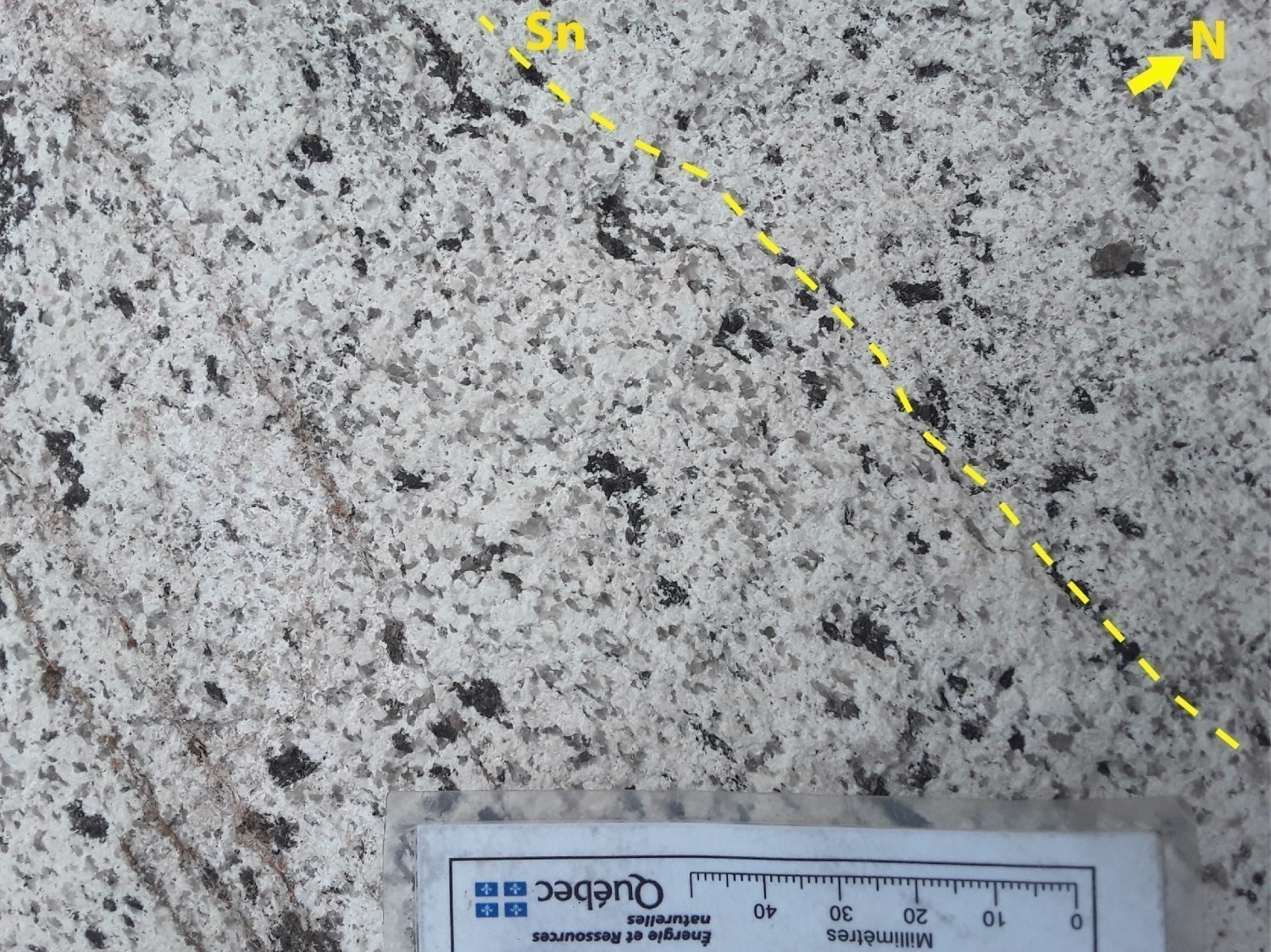
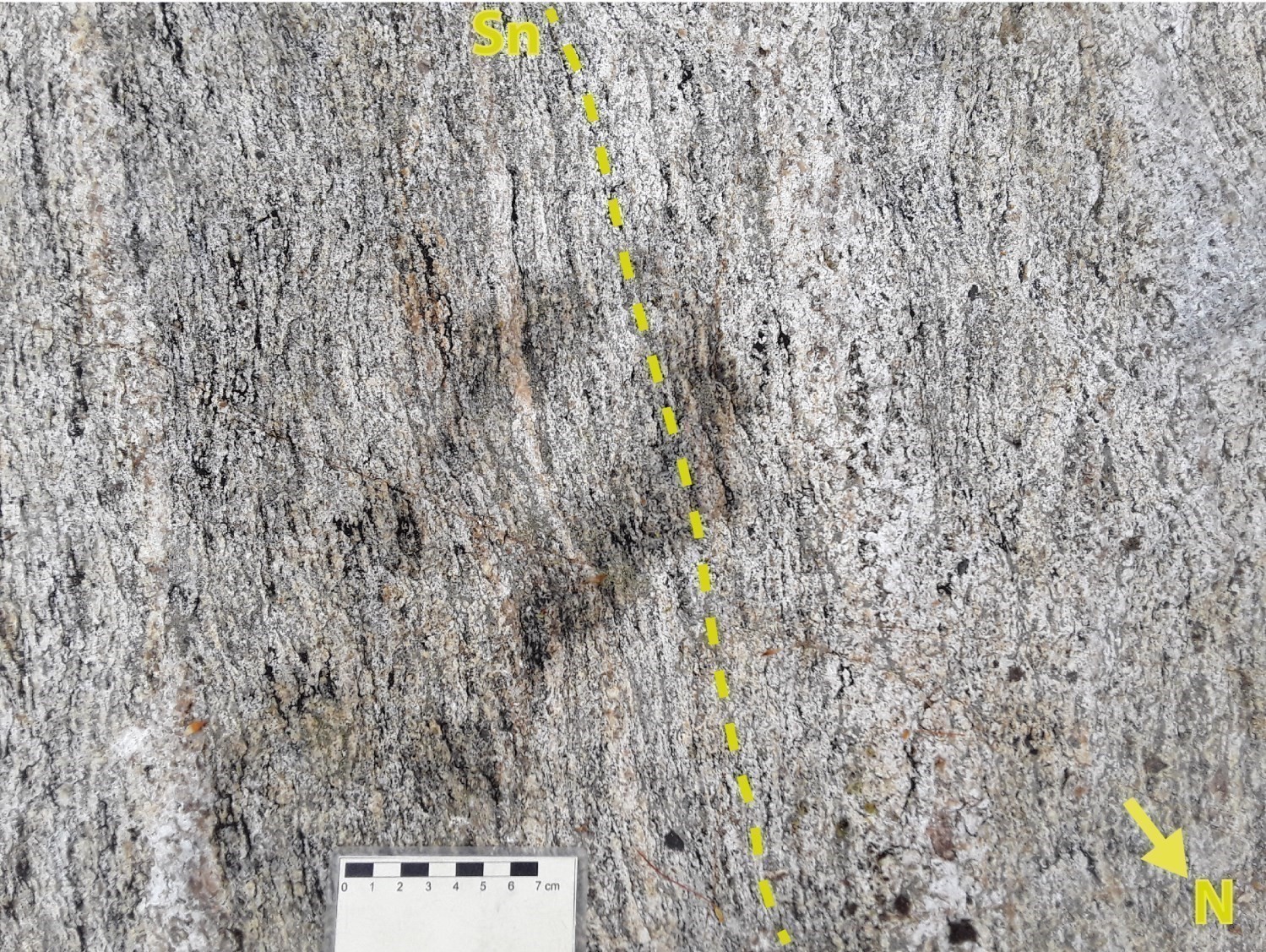
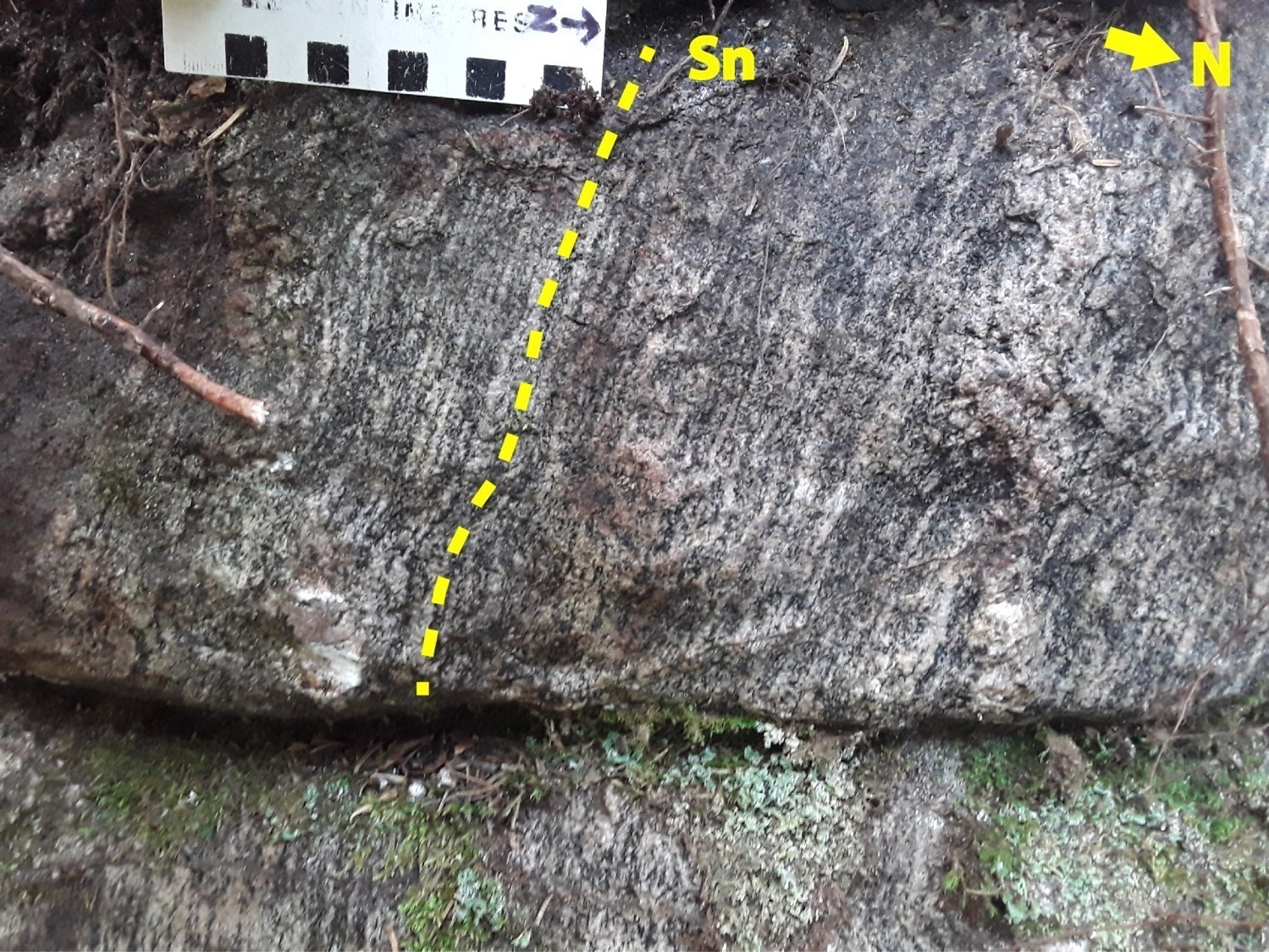
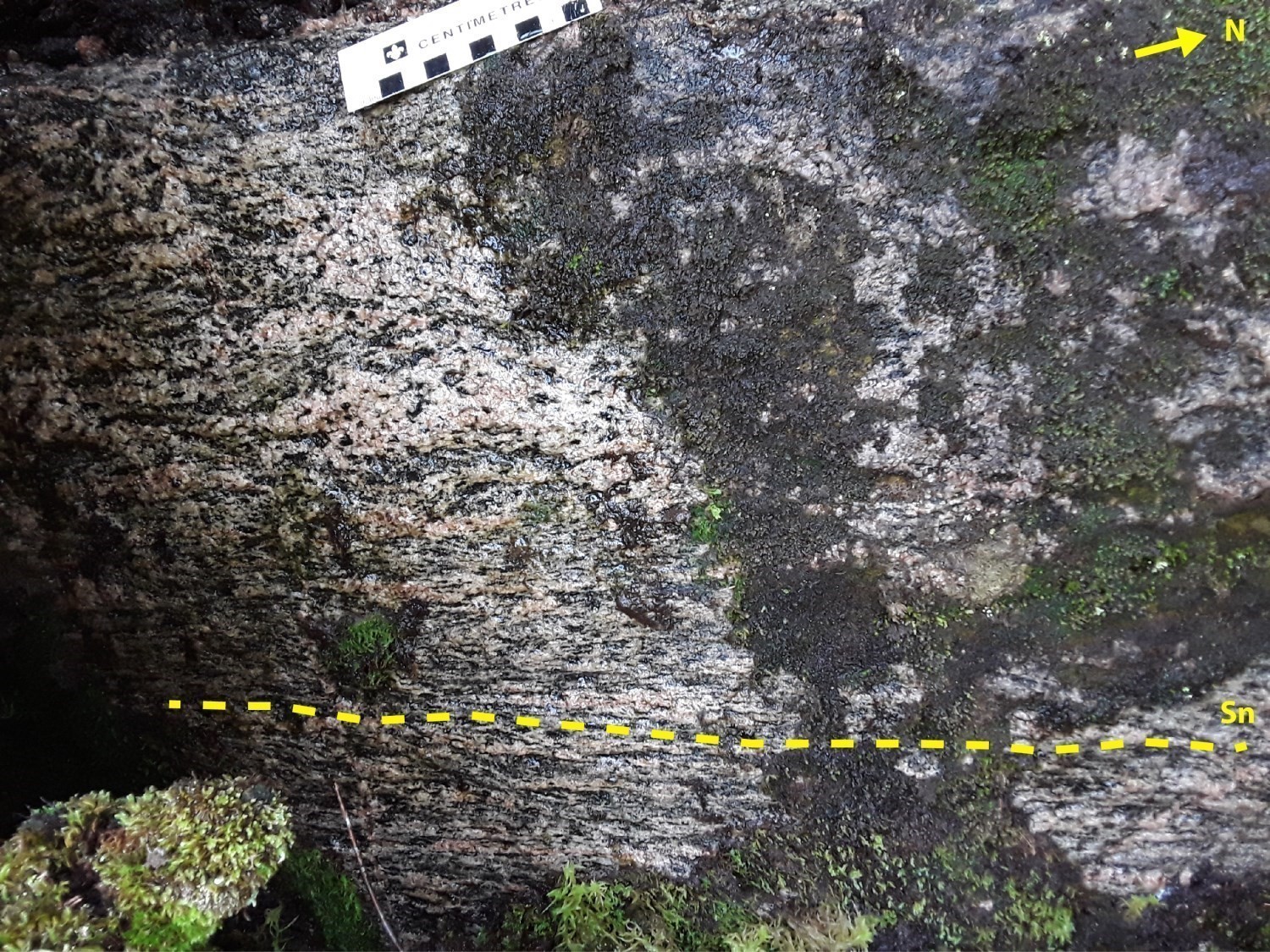 In the metasedimentary rocks of the Barrois Complex, the Sn foliation is marked by a migmatitic banding, or a gneissosity characterized by the alternation of light and dark levels, respectively poor and rich in ferromagnesian minerals. In the intrusive rocks of the Festins (mPfes), Vertu (mPvet2) and Adélard (mPade) Plutonic Suites, the Sn planar fabric is expressed by a tectonometamorphic mineral foliation, gneissosity, foliation or diffuse mylonitic or migmatitic banding underlined by the preferred orientation of the ferromagnesian minerals or by the flattening and the preferred orientation of the minerals constituting the rock.
In the metasedimentary rocks of the Barrois Complex, the Sn foliation is marked by a migmatitic banding, or a gneissosity characterized by the alternation of light and dark levels, respectively poor and rich in ferromagnesian minerals. In the intrusive rocks of the Festins (mPfes), Vertu (mPvet2) and Adélard (mPade) Plutonic Suites, the Sn planar fabric is expressed by a tectonometamorphic mineral foliation, gneissosity, foliation or diffuse mylonitic or migmatitic banding underlined by the preferred orientation of the ferromagnesian minerals or by the flattening and the preferred orientation of the minerals constituting the rock.
The mineral lineations carried by these planar fabric are, in general, tectonometamorphic or stretching mineral lineations. They have a mean direction of 145° and a dip component (mean Ln: 145°/32°).
| Main Fabric | Type of Fabric | Direction (°) | Dip / Plunge (°) | Number of Measurements |
| Sn foliation | Tectonometamorphic mineral foliation, gneissosity, mylonitic foliation or banding and migmatic or tectonic banding | 37 | 32 | 155 |
| Ln lineation | Secondary tectonometamorphic mineral lineation and stretch lineation | 145 | 32 | 83 |
❯ Other Fabrics
 In the Adelard Structural Domain, the Sn+1 tectonometamorphic foliation has been observed in only a few outcrops where it cuts the Sn foliation. It is rarely measured, as it is confused with the main Sn fabric. In general, it is characterized by the flattening of quartz grains, feldspar grains, or both, as well as by a preferred orientation of ferromagnesian minerals (biotite), which is clearly visible at the level of fold hinges.
In the Adelard Structural Domain, the Sn+1 tectonometamorphic foliation has been observed in only a few outcrops where it cuts the Sn foliation. It is rarely measured, as it is confused with the main Sn fabric. In general, it is characterized by the flattening of quartz grains, feldspar grains, or both, as well as by a preferred orientation of ferromagnesian minerals (biotite), which is clearly visible at the level of fold hinges.
❯ Folds
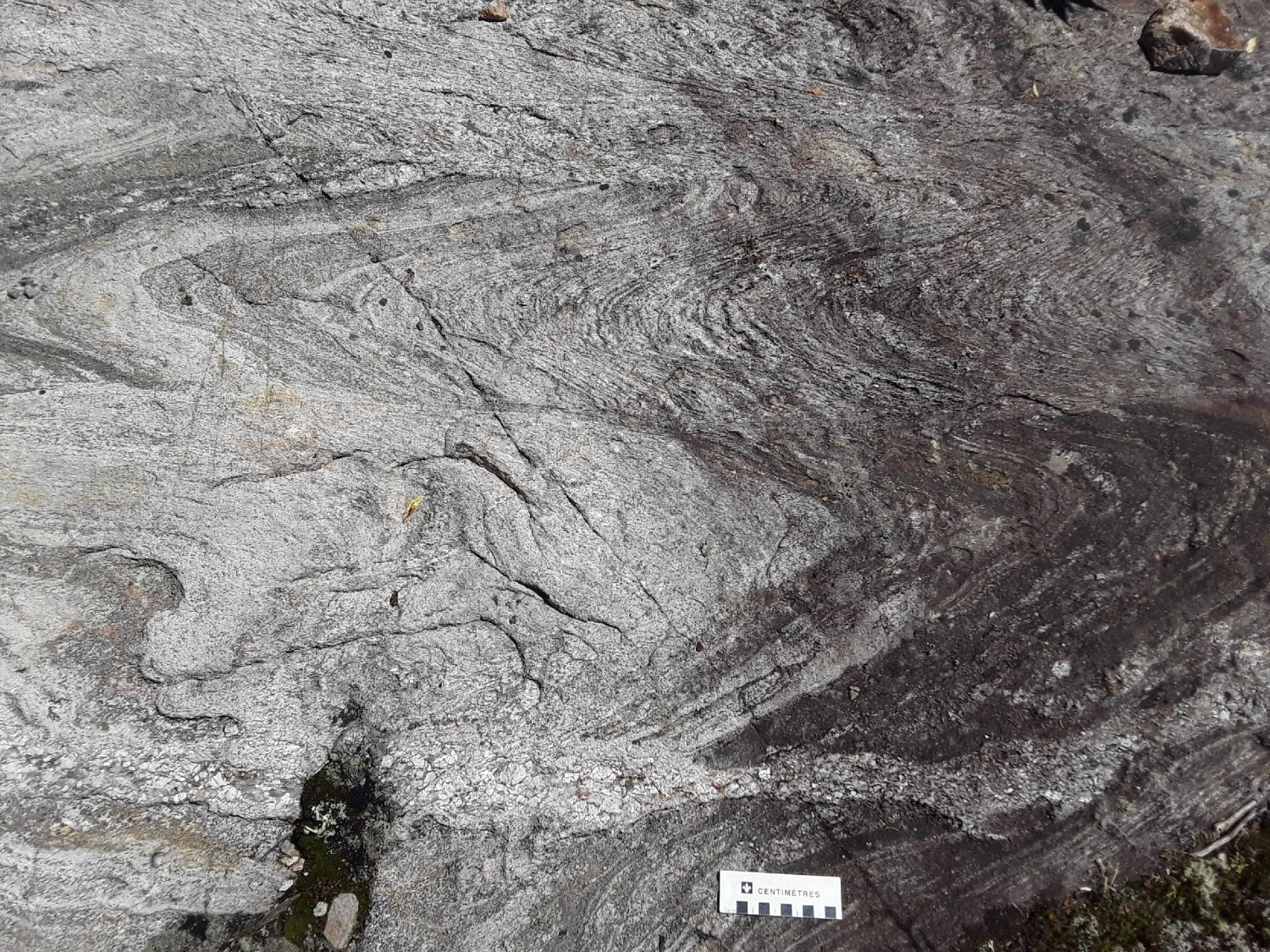 Analysis of the distribution of geophysical lineaments, interpreted from planar fabric measurements and maps of the total magnetic field and its derivatives (Intissar and Benahmed, 2015), allows the distinction of at least two families of folds in the Adélard Structural Domain (DSade).
Analysis of the distribution of geophysical lineaments, interpreted from planar fabric measurements and maps of the total magnetic field and its derivatives (Intissar and Benahmed, 2015), allows the distinction of at least two families of folds in the Adélard Structural Domain (DSade).
Geometric Parameters of Regional Folds:
| Fold or Family of Folds | Type (Anticline, Syncline or Undetermined) | Shape (Antiform or Synform) | Attitude (Overturned or Upright) | Axial Plane | Fold Axis | Position (Certain or Probable) | Deformation Phase | ||
| Direction | Dip | Direction | Plunge | ||||||
| NE-SW family | – | Antiform and synform | Upright and overturned | NE-SW | – | – | – | Probable and certain | – |
| NW-SE family | – | Antiform and synform | Overturned | NW-SE | – | – | – | Certain | – |
❯ Crosscutting Relationships
The Adélard Structural Domain is crossed by faults and shear zones deduced from field observations and/or maps of the aeromagnetic field and its derivatives (Intissar and Benahmed, 2015).
To the south of the domain, in the Festins Plutonic Suite, there are two kilometre-scale NE-SW faults of undetermined and reverse movement, respectively. The reverse fault enables the contact of an enclave from the Barrois Complex (mPboi4) with its host rock (mPfes). In the western part of the suite, two NW-SE shear zones of dextral and undetermined movement and a NE-SW fault of undetermined movement cut through the rocks of the suite.
East of the Adélard Plutonic Suite, a ~5.5 km long, NE-SW fault cuts the suite rocks. Its movement is undetermined.
Geometric Parameters of Regional Faults Cutting the Adélard Structural Domain:
| Fault or Family of Faults | Type | Mean Direction | Mean Dip (°) | Lineation Plunge in the Fault Plane | Estimated Width (m) | Estimated Length (km) | Apparent Movement | Position |
| NE-SW family | Regional faults | NE-SW | ~45 | – | <100 ? | 2 to 7.5 | Undetermined and reverse | Certain |
| NW-SE family | Shear zones | NW-SE | ~80 | – | <50 ? | 2 to 6 | Dextral and undetermined | Certain |
❯ Kinematics
Does not apply.
Deformation Style
The Adélard Structural Domain has undergone moderate to strong deformation characterized by a well-developed planar fabric, which is more or less homogeneous and pervasive between the outcrops of each lithostratigraphic unit. The Sn planar fabric represents the early phase of deformation and is marked mainly by secondary mineral foliation, or mylonitic banding in the intrusive rocks or gneissosity in the metasedimentary rocks of the area. The domain underwent a second phase of deformation (Sn+1) characterized by folds (NE-SW and NW-SE) marked by the flattening of quartz and feldspar grains and the preferred orientation of (ferromagnesian) minerals, especially at the hinges. The orientation of the axial planes would indicate a major NW-SE compression.
Metamorphic Characteristics
Ten samples, which are representative of the lithostratigraphic units of the Adélard Structural Domain, were studied under a polarizing microscope to determine the type of metamorphism and the spatial distribution. The mineralogical parageneses and petrographic characteristics of these samples show that the metamorphic conditions within this domain have reached granulite facies characterized by the presence of orthopyroxene in all lithostratigraphic units, with the exception of a few places in the upper amphibolite facies.
The presence of orthopyroxene and perthite (potassium feldspar in albitic exsolution) in the rocks of the Festins, Vertu and Adélard Plutonic Suites reflects temperatures typical of granulite facies (≥600 °C). In places, we observe an assemblage of ferromagnesian minerals with biotite and hornblende (without pyroxene) as well as the phenomenon of uralitization of orthopyroxene into hornblende or biotite that can be explained by retrograde metamorphism in the amphibolite facies.
Alterations
Not observed.
Geophysical Characteristics
Magnetic textures observed on the high-resolution residual magnetic field map (Intissar and Benahmed, 2015) in the Adélard Structural Domain show that it is divided into three parts. In the south, the magnetic pattern shows a more or less elliptical ring texture of low contrast and high magnetism in the units of the Festins Plutonic Suite.
In the centre of the domain, the magnetic texture is contrastingly banded with low to medium magnetism corresponding to units of the Vertu Plutonic Suite (mPvet2). An elliptical N-S elongated high magnetism anomaly within this domain corresponds to an enclave of the Barrois Complex (mPboi4). To the north of the domain, the rocks of the Adélard Plutonic Suite (mPade) show a low-contrast, highly magnetic, more or less elliptical to circular (in places) magnetic ring texture with weak banding.
Chronological Markers
Does not apply.
References
Publications Available Through Sigéom Examine
El BOURKI, M., MOUKHSIL., A. 2022. Géologie de la région de Dolbeau-Blondelas, Province de Grenville, région du Saguenay–Lac-Saint-Jean, Québec, Canada. MERN; BG 2022-02, 1 plan.
INTISSAR, R., BENAHMED, S., 2015. Levé magnétique aéroporté dans le secteur ouest du Lac-St-Jean, Province de Grenville. MERN, GOLDAK AIRBORNE SURVEYS. DP 2015-06, 7 pages and 2 plans.
Suggested Citation
Contributors
|
First publication |
Mhamed El Bourki, GIT, M.Sc. mhamed.elbourki@mrnf.gouv.qc.ca; Abdelali Moukhsil, P. Geo., Ph.D. abdelali.moukhsil@mrnf.gouv.qc.ca (redaction) Ghyslain Roy, P.Geo. (coordination); Fabien Soldagi, P.Geo., Ph.D. (critical review); Simon Auclair, P.Geo., M.Sc. (editing); André Tremblay (HTML editing); Catherine Tremblay (English version). |

